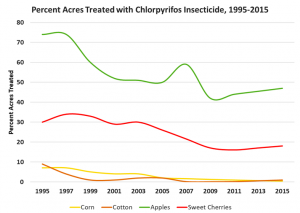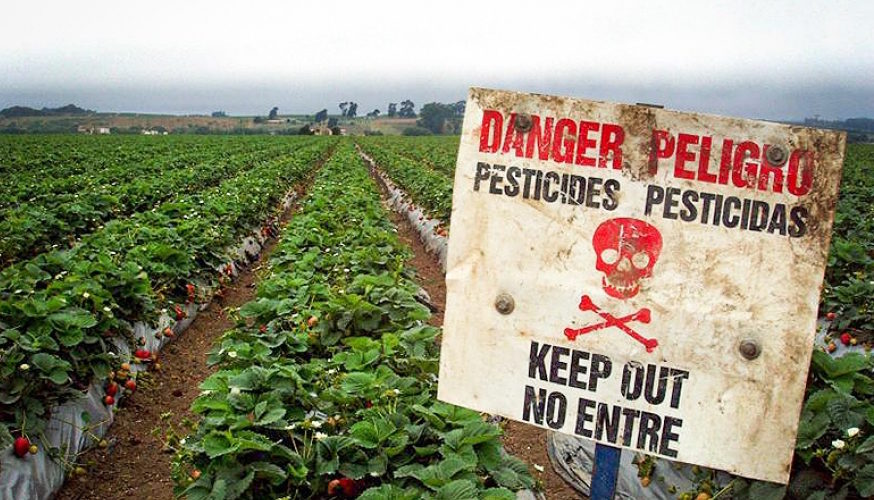First, the back story.
Over the years, the USDA has almost always sided with pesticide manufacturers and farmers, in opposition to EPA efforts to curtail or end the use of high-risk pesticides.
The arguments advanced by the USDA are always basically the same:
- There are no viable alternatives to this pesticide.
- Consumers will face food shortages without future access to this pesticide.
- EPA’s calculation of risks are overblown.
- Plus, growers have taken steps to reduce risks.
Since the 1990s, the Dow AgroSciences’s insecticide chlorpyrifos has been the most controversial, high-risk insecticide under the gun at EPA.
This hot (i.e., toxic) organophosphate (OP) insecticide causes birth defects and disrupts neurological development (see a bibliography of peer-reviewed papers on the subject here), shaving off at least a few percent of IQ across a significant share of the babies born in the U.S. over the last three decades.
After years of study and debate triggered by passage of the historic Food Quality Protection Act (FQPA) in 1996, EPA finally found the data — and backbone — to say enough is enough in 2016, and started the process to end all food crop uses of chlorpyrifos.
But in one of his first official acts as the newly appointed Administrator of EPA, Scott Pruitt overturned his agency’s decision to end chlorpyrifos use, and like Lazarus, chlorpyrifos has arisen from the dead to poison farmworkers and grace our meals with low-level residues, once again.
What’s a few IQ points among friends, anyway?
The Ninth Circuit of Appeals Court Weighs In
A coalition of farm worker and environmental groups had been pushing the EPA to ban chlorpyrifos for over a decade.
In essentially each round in the litigation, the groups have prevailed and courts have ordered the EPA to get on with their decision process, leading to one of two lawful outcomes under the FQPA:
- The EPA could determine, and declare that there is “a reasonable certainty of no harm” from ongoing, well-documented exposures to chlorpyrifos, and hence the registrations and tolerances can remain on the books. Use would continue.
- Exposures and risks do not meet the “reasonable certainty of no harm” standard, and hence chlorpyrifos uses would have to be curtailed, or ended.
In reversing the Obama-EPA ban, the Pruitt-led EPA did not issue a determination that exposures and risk met the FQPA’s “reasonable certainty of no harm.” Instead, the EPA just said prudent steps to reduce exposures were in place, and new data and better science was needed to make a definitive determination about risk levels.
But since the EPA had been collecting new data and sharpening its chlorpyrifos risk assessment ever since passage of the FQPA in 1996, the NGOs filed an appeal of Pruitt’s reversal of the ban to the U.S. 9th Circuit Court of Appeals. The Court’s decision is highly critical of the EPA, and orders the EPA to initiate a process leading to the end the remaining uses of chlorpyrifos within 90 days (see the ruling here).
The USDA Weighs In

On September 24, 2018, the USDA’s Office of Communications issued this — “Secretary Perdue Statement on DOJ Filing in 9th Circuit Chlorpyrifos Ruling.”
In the statement, Secretary Perdue praised the decision by the Department of Justice to request a rehearing before the 9th Circuit Court of Appeals of the chlorpyrifos case, in the hope the Court would change its mind, and give chlorpyrifos another new lease on life.
The remarkable statement by Secretary Perdue begins by saying:
“USDA disagrees with the ruling ordering EPA to revoke tolerances and cancel registrations for chlorpyrifos. The decision appears to be based on a misunderstanding of both the available scientific information and EPA’s pesticide regulatory system.”
In fact, the Court of Appeals decision was driven by the EPA’s most recent in-depth risk assessment, coupled with the agency’s unwillingness to declare that there is a “reasonable certainty of no harm” from continued use of chlorpyrifos.
The science is clear, chlorpyrifos is dangerous, particularly to children. In fact, the American Academy of Pediatrics formerly objected to the decision to reverse the chlorpyrifos ban. So, the Court of Appeals decision clearly stuck to the scientific record and the law.
Secretary Perdue goes on to assert:
“The costs of an incorrect decision on chlorpyrifos are expected to be high and would cause serious impacts to American farmers working to feed, fuel, and clothe the United States and the world.”
This is simply not true. As data from our Pesticide Use Data System (PUDS) reveals, the use of chlorpyrifos has been falling for years (see the chart below for details). Plus, resistance in a number of target insects is widespread and farmers have moved on to other methods in insect pest management, including GMO crops in corn and cotton.

Secretary Purdue goes on to say “This ruling, which would mean the sudden and total loss of chlorpyrifos, prevents farmers from using an effective and economical crop protection tool.”
But, EPA almost never does anything suddenly. Under the Obama cancellation order, it would be a few years before all uses of chlorpyrifos were ended, and it would take several years to cancel all tolerances and deal with residues on imported food.
Secretary Purdue — “For some crops and target pests, chlorpyrifos is the only line of defense, with no viable alternatives.”
This also is simply not true, except perhaps on the few farms where pest managers do nothing in response to ending use of chlorpyrifos (e.g., adding several proactive steps to reduce insect pest pressure).
Chlorpyrifos emerged from World War II research conducted by the Germans on possible human nerve gases. Its potent impact on insects was discovered in the 1950s, and its use in agriculture expanded in the 1960s and 1970s. It’s adverse impacts on people, and especially babies and children, were first recognized in the 1980s, and has received sharp focus since the 1990s.
By the late-2000s, the science overwhelmingly supported a link between prenatal exposures to chlorpyrifos and adverse birth outcomes, especially impaired neurological development.
Chlorpyrifos stands as one of the most important insecticides shaping insect pest management systems in the second half of the 20th Century. Hopefully farmers and the ag community will realize that Secretary Purdue’s effort to keep chlorpyrifos on the market for another few years is a fool’s errand on the wrong side of history.
Instead, the Secretary of Agriculture should use his pedestal, and Office of Communications, to accelerate progress toward safer, more sustainable ways to manage insects that pose no threat to the IQ of the next generation of Americans.
Source:
United States Department of Agriculture, “Secretary Perdue Statement on DOJ Filing in 9th Circuit Chlorpyrifos Ruling,” Press Release No. 0196.18, USDA Office of Communications, 09/24/2018.

